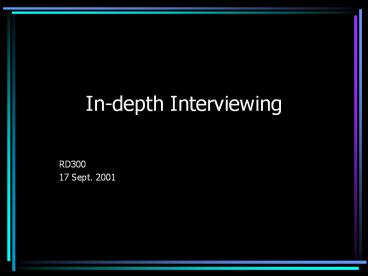In-depth Interviewing PowerPoint PPT Presentation
1 / 19
Title: In-depth Interviewing
1
In-depth Interviewing
- RD300
- 17 Sept. 2001
2
DEFINITION
- In-depth interviewing a conversation between
researcher and informant focusing on the
informants perception of self, life and
experience, and expressed in her or his own words.
3
Interview Models
Structured interviews Focused or semi-structured interviews Unstructured interviews
Survey interviews In-depth interviews Group interviews Surveys In-depth interviews Group interviews Oral histories
4
Structured Interviews
- Standardized questions.
- Detailed interview schedule (e.g.Questionnaire).
- Each respondent asked exactly the same questions
in the same order. - Predominately close-ended questions (e.g. Yes/No
scales).
5
Close-ended Questions
- Respondent must choose among several preset
answers. - Questions are inflexible.
- Easier to code.
- Less costly than open-ended questions.
- Limited amount of information gathered.
6
Open-ended Questions
- Respondent can give any answer.
- Harder to compare data across respondents.
- More time consuming to code. Cost factor.
- Lets respondents speak to issues important to
them. - Data is richer.
7
Semi-structured or Focused Interviews
- Interviewer uses an interview guide developed
around the issues central to the research
question. - Interview guide - a list of topics without fixed
wording or fixed ordering of questions. - Allows in-depth examination of issues.
8
Unstructured Interviews
- No formal interview schedules or question order.
- A minimally controlled conversation geared toward
the researchers topics of research interest.
9
In-depth Interviewing
- A conversational process.
- Unstructured or semi-structured format.
- Typically conducted face-to-face.
- Often involves repeated interviews with the same
respondent. - Relies on verbal accounts of social realities.
- Typically individual interviews but can be groups.
10
In-depth Interviewing
- Predominantly used for theory building as opposed
to hypothesis testing. - Often used in exploratory studies.
- Results may be used to design a questionnaire.
11
Conducting the Interviews
- Who will you interview?
- How many respondents/informants will be
interviewed? - How many interviews will you conduct?
- How long should you allow for the interviews?
- Where do you conduct the interviews?
12
Conducting the Interviews
- How much information do you give the informant?
- Confidentiality is an issue.
- Establish a rapport.
- Prepare in advance. Do you homework.
- Prepare an interview guide.
- Use transitions during interview to keep on track.
13
Conducting the Interviews
- Be a good listener and observer.
- Funneling broad questions progressing to more
specific issues. - Story-telling Asking questions so as to elicit
a story from the respondent. - Written narratives.
14
Types of Questions
- Descriptive broad, good starter questions.
- Structural questions explore how respondents
organize their knowledge. - Contrasting respondent must make a comparison.
- Opinion/value What is your opinion of.?
15
Types of Questions
- Feeling questions Emotional responses. How do
you feel about that? - Sensory Questions about sensory perceptions
(seen, heard, touched, etc.). - Background demographic questions.
16
Probing
- Questions used to elicit more information after
an initial question. Follow-up questions. - Devils advocate questions.
- Hypothetical questions.
- Posing the ideal.
17
Forms of Probing
- Non-verbal nudging.
- Verbal nudging.
- Reflective probe or paraphrase.
18
Recording the Interview
- Tape-recording.
- Note taking.
- Each has advantages and disadvantages.
- May be used in combination.
19
Listening Skills
- Empathic listening.
- Non-judgmental or tolerant appearance.
- Good advance preparation helps.
- Listening skills improve with practice.

